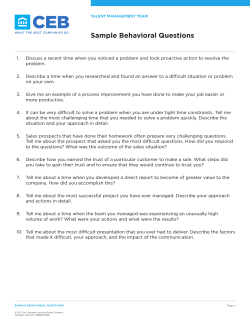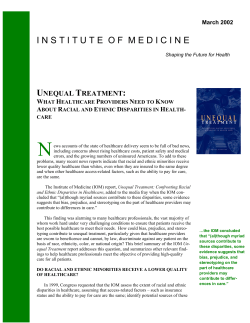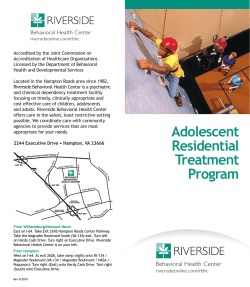
A Federal Perspective on Community Defined Evidence Practices & Reducing Disparities
A Federal Perspective on Community Defined Evidence Practices & Reducing Disparities Larke Nahme Huang, Ph.D. Director, Office of Behavioral Health Equity With Assistance from Krystle Canare Best Practices in Our Communities Conference Pacific Clinics San Gabriel, CA October 8, 2014 Key Questions 2 Overarching Question: How Can CDEP reduce disparities in behavioral health care? 1. Are we making progress in reducing disparities in behavioral health? 2. Why do we need Community defined evidence practices (CDEP) and access strategies? 3. SAMHSA supported CDEP activities 4. CDEP and the Affordable Care Act 2 Definition of Health Disparity (Healthy People 2020) 3 Health disparity, “a particular type of health difference that is closely linked with social, economic, and/or environmental disadvantage. Health disparities adversely affect groups of people who have systematically experienced greater obstacles to health based on their racial or ethnic group; religion; socioeconomic status; gender; age; mental health; cognitive, sensory, or physical disability; sexual orientation or gender identity; geographic location; or other characteristics historically linked to discrimination or exclusion.” What is a health disparity? 4 “A particular type of health difference that is closely linked with social, economic, and/or environmental disadvantage.” Healthy People 2020 5 1. ARE WE MAKING PROGRESS IN REDUCING BEHAVIORAL HEALTH DISPARITIES? Suicide rates by ethnicity and age group -- United States, 2007-2011 6 35 25 20 Eur-Amer NonLatino Afr-Amer NonLatino Native American Asian-PI Latino 15 10 5 65 + -6 4 60 -5 9 55 -5 4 50 -4 9 45 -4 4 40 -3 9 35 -3 4 30 -2 9 25 -2 4 20 -1 9 15 -1 4 10 -0 9 05 -0 4 0 00 Rate per 100,000 population 30 Age Group in years Unadjusted crude rates per 100,000 population; A. Crosby, CDC, 2014 Latina/o Adolescent Suicidal Risk Behaviors 7 Percentage of Students by Race/Ethnicity and Sex 45 41.4 40 34.3 35 31.4 30 25 Latino Female 24.4 Latino Male 20.7 20 21 18 15 18.4 17.4 12.8 12.6 9 10 Black Female 17.6 Black Male 13.9 13.5 13.7 11.1 White Female 10.6 8.4 8.8 6.9 White Male 7.7 7.9 4.6 5 0 Felt Sad or Hopeless Seriously Considered Attempting Suicide Made a Suicide Plan Attempted Suicide Source: Center for Disease Control, 2011 . Data from: self-report survey. 15,425 students, grades 9-12: administered September 2010- December 2011; 43 states http://www.cdc.gov/healthyyouth/yrbs/pdf/us_disparityrace_ Major Depressive Episode (MDE) in the Past Year, Age12-17 by Race and Hispanic Origin 8 Had at Least One MDE in the Past Year, Age 12-17, by Race and Hispanic Origin: 2009-2010 Percentage (%) with MDE in the Past Year, Age 12-17 10 9 8.3 8.5 8 9.4 7.9 6.8 7 7.5 7.9 7.6 7.4 7.7 7.8 5.6 6 5 4 2009 3 2010 1.8 2 1 0 0 White Black or African American Indian or Native Hawaiian or American Alaskan Native Other Pacific Islander Race and Hispanic Origin Asian Two or More Races Hispanic or Latino Note: Where no estimate was reported due to low precision 0.0 was used. SAMHSA, National Household Survey on Drug Use and Health (NSDUH), 2009 and 2010 ≥1 MDE in Past Year and Receipt of Treatment in the Past Yr for Depression, Age 12-17 9 Received Treatment in the Past Year, Age 12-17 with MDE, by Race and Hispanic Origin: 2009-2010 45 Percentage (%) with MDE that Received Treatment in thePast Year, Age 12-17 40 41.2 38.6 37.6 33.1 35 30 25.4 23.1 25 20 2009 15 2010 10 7.5 7.4 5 0 0 0 0 0 0 0 White Black or African American Indian Native Hawaiian American or Alaskan Native or Other Pacific Islander Race and Hispanic Origin Asian Two or More Races Hispanic or Latino Note: Where no estimate was reported due to low precision 0.0 was used. SAMHSA, National Household Survey on Drug Use and Health (NSDUH), 2009 and 2010 Trends in Disparities 2000-2002—2008-2010 (AHRQ,NHDR) 10 Quality of Care Access to Care Disparities in 2012 (AHRQ, Natl Health Disparities Report, 2012) 11 Quality of Care Access to Care Neighborhood and Built Environment Economic Stability Health and Health Care Social Determinants of Health Education 12 Social and Community Context/Justice Involvement Demographics of the JusticeInvolved Population 13 High Rates of Illness Among JusticeInvolved Population 14 Health Disparities Upon Release 15 • Increased mortality following release (12x higher) • High rates of hospitalization for former inmates at reentry 2.5x higher within a week of release (1 in 70) 1.8x higher within 90 days of release (1 in 12) • Chronic health and behavioral health conditions are often exacerbated by lack of accessibility to health care after release • In a majority of states, imprisonment leads to termination of Medicaid benefits Housing: Moving to Opportunity Study 16 • HUD/NIMH Study • Randomized moving families in concentrated poverty, public housing to lesser poverty areas. • Results: – Decrease in mother’s depression – Decrease in mother’s diabetes – Findings associated with sleep patterns/hypervigilance? – Mixed result for youth, academics, mental health 17 2. WHY DO WE NEED COMMUNITY –DEFINED EVIDENCE STUDIES/PRACTICES? “Clozapine, gold standard for treatment-resistant schizophrenia…a different story for African Americans” 18 • Key risk: agranulocytosis, a condition defined by white blood cell (WBC) counts dropping to extremely low levels that place a person at high risk for infection • Key disparity involved in clozapine re the ANC ranges, which are currently normed to White patients • Normative ANC levels vary among racial and ethnic groups, and some have normatively lower ANC than White Americans, including African Americans • Deficit in mean ANC across racial/ethnic groups benign ethnic neutropenia (BEN) doesn’t reduce ability to resist infection • But, given lack of “evidence-testing” across groups An estimated 20% of African Americans may be ineligible to begin clozapine because of BEN, and another 25% who begin may discontinue due to normal hematologic variation “Study finds a racial gap in benefits of exercise” 19 • “At equal rates of activity with whites, black adolescent females were more likely to be obese” • Among black girls who were most active at age 12, obesity at age 14 was nearly as likely as for those who had far lower activity rates. This did not hold true for white female adolescents. • Findings point to a significant metabolic disadvantage for African American girls • Thus, obesity prevention interventions need to be adapted to account for less sensitivity to effects of physical activity among black girls White & Jago, Archives of Pediatrics and Adolescent Medicine, 2012 “… it is unsurprising that preliminary data on applying current interventions to couples targeted by federal initiatives have been disappointing.” 20 • Healthy Marriage Initiative: based on linkage between marriage and well-being; decreasing poverty, improve child outcomes • A decade of federal initiatives to promote marital interventions for poor couples and couples of color • Focus: help couples access marriage education services, acquire skills/knowledge to form healthy marriages • However, most interventions studies based on mostly white and middle class couples • Since 2007 ~ $100M appropriated to these programs; findings are mixed, little impact • For poor families: paying rent, keeping children safe, finding better schools are urgent matters; “focusing on marriage seems self-indulgent” when working hard to raise children M Johnson, American Psychologist, May-June 2012 “Disparities in use of mental health services persist for Black and Latino children” 21 • “About 10% of white youth are using mental health care compared to 4 - 5% of Black and Latino youth” • “That 2-to-1 ratio is giant disparity compared to other areas of health care” • Money spent for MH care increased for white children; decreased significantly for Latino children (2002-2003 and 2006-2007) • “…the amount of dollars the system is spending on Latino users relative to white users is shrinking.” • But, when strategies are used to engage these families access to MH care increases. B. Cook, Health Services Research, 2012; Dataset: 30,000 youth, Medical Expenditure Panel Surveys. Special Analysis for Surgeon General’s Report on Culture, Race and Ethnicity 22 • Between 1986 and 2001, ~ 10,000 participants were included in randomized controlled trials evaluating the efficacy of interventions for four mental health condition (bipolar disorder, schizophrenia, depression and ADHD) and included only: – – – – 561 African Americans (5.6%) 99 Latinos (.01%) 11 Asian Americans and Pacific Islanders (.001%) 0 American Indians and Alaska Natives were available for analysis. – Not a single study analyzed the efficacy of the treatment by ethnicity or race. (Miranda et al., 2003) 22 Most Commonly Spoken Languages Other than English or Spanish (2014) 23 24 3. SAMHSA SUPPORTED CDEP ACTIVITIES (1)SAMHSA’s Community-defined Evidence Project 25 Purpose: • Identify “effective” community and/or culturally based practices, who is doing them and how they are being done • Determine common characteristics or “essential elements” among these practices • Identify formal or informal measurement of effectiveness that is being used with such practices; document the measures • Identify culturally-informed methodologies and measurement practices that involve the community 25 Community Defined Evidence 26 • A research model that emphasizes investigation “from the ground up” • Key assumption: service recipients have knowledge based upon life experience and learned expertise that is rarely tapped to inform scientific study and develop behavioral health practices. • Identify and affirm alternative and existing forms of knowledge about behavioral health and wellness • Use traditional and indigenous ways of knowing to develop and implement practices that are acceptable and useful to the populations that are expected to use them Kenneth J. Martinez, Psy.D. 26 Community Defined Evidence 27 • CDE is a set of practices that have been found to yield positive results as determined through ongoing efforts to achieve community consensus, and which have reached a level of acceptance by service recipients despite varying degrees of empirical measurement of practice effectiveness. (Martinez, et al. 2010; 2012) 27 Criteria Used to Review Identified Practices in CDEP Project 28 1) 1. A process that includes the community 2) 2. Develop a practice with community involvement and expertise 3) 3. Test and implement the practice, including community input 4) 4. Assess implementation and utilization of the practice 5) 5. Continuous quality improvement process Kenneth J. Martinez, Psy.D. 28 Essential Elements in CDEP Practices (K. Martinez, et al.) 29 1. Acknowledging the centrality of the family 2. Creating and encouraging a collective healing process 3. Addressing needs holistically 4. Addressing stigma and using culturally relevant terms 29 Essential Elements In CDEP Practices (K. Martinez, et al.) 30 5. Engaging in dialogue about the practice with community members and service recipients on an ongoing basis 6. Increasing community connections by partnering with organizations important to local ethnic communities 7. Implementing practice in comfortable and familiar practice settings 30 California Reducing Disparities Project 31 • Build on CDEP Concept • Response to Surgeon General’s 2001 Report and 2003 President’s New Freedom Commission Report • Investment from Mental Health Services Act (former DeptMH) • 5 Strategic Planning Workgroups(SPW) formed to serve 5 populations (African Americans, AAPI, Latinos, LGBTQ, Native Americans) • Phase 1: Develop strategic plan to reduce mental health disparities in 5 populations and ID promising practices • Outcome: Population Reports • Phase 2: Fund and evaluate promising practices/communitydefined evidence programs (2) SAMHSA’s Service to Science Initiative (STS) 32 • Goal: Build evaluation capacity of locally developed programs to demonstrate more credible evidence of their program’s effectiveness • Support innovative local interventions • 243 programs have participated What is provided in STS? 33 • Evaluation training and Technical assistance – Feasibility study; improving staff/community evaluation capacity and use of data; plans for data analysis; develop/improve evaluation instruments; process and outcome evaluations with stakeholder input • Seed money to CBOs; $30,000 • Preparation of manual (3) National Network to Eliminate Disparities in Behavioral Health (NNED) 34 34 To join the NNED: www.nned.net http://share.nned.net/ 35 NNED Workforce Focus: Communities of Practice 36 • Bienvenido Program – Mental Health Promotion for Latino Communities (Spanish-speaking) • Project Youth Venture – Tribal Youth Substance Abuse Prevention • Latino Multi-Family Group Therapy • Motivational Interviewing • Developing Diverse Peer Specialists • Strengthening Families • Cognitive Behavioral Therapy, Adapted for Latinos • Project ASIST for Tribal Suicide Prevention • Health Reform: Outreach and Enrollment • NNEDLearn Training Meeting (4) Grant- making: RFA Language 37 • “SAMHSA’s services grants are intended to fund services or practices that have a demonstrated evidence base and that are appropriate for the population(s) of focus. An evidence-based practice (EBP) refers to approaches to prevention or treatment that are validated by some form of documented research evidence.” • “SAMHSA recognizes that EBPs have not been developed for all populations and/or service settings.” • “Applicants proposing to serve a population with an intervention that has not been formally evaluated with that population are required to provide other forms of evidence that the practice(s) they propose is appropriate for the population(s) of focus. Evidence for these practices may include unpublished studies, preliminary evaluation results, clinical (or other professional association) guidelines, findings from focus groups with community members, etc.” (5) What is the Disparity Impact Strategy? (DIS) 38 Systems change process in response to policies aimed to improve health outcomes by: – Creating a more strategic focus on racial and ethnic populations in SAMHSA investments – Using a data-informed quality improvement approach to address racial and ethnic disparities in SAMHSA programs; including CDEP approaches – Utilizing this secretarial priority to influence how SAMHSA does it work, e.g., its grant-making operations HHS Action Plan to Reduce Racial and Ethnic Health Disparities (2011) 39 Secretarial Priority #1 1. Assess and heighten the impact of all HHS policies, programs, processes, and resource decisions to reduce health disparities. HHS leadership will assure that: (c)Program grantees, as applicable, will be required to submit health disparity impact statements as part of their grant applications. Such statements can inform future HHS investments and policy goals, and in some instances, could be used to score grant applications if underlying program authority permits What Does the Disparity Impact Strategy Mean for Grantees? 40 • No new data burden; uses the required performance measures • No change in primary programmatic intent • Focus on how programs engage/perform in regard to racial/ethnic subpopulations (LGBT, where data collected) • Data on racial/ethnic subpopulations used for quality improvement (QI) in the program (LGBT, where available) • Strategies implemented for how grant programs can improve performance for racial/ethnic subpopulations • Required “Disparity Impact Statement” linked to funding Disparity Impact Strategy: Operational Framework 41 Access Use Outcomes Disparity Impact Strategy: Initial Observations 42 • Increase attention to vulnerable populations • Increase access to federal resources and involvement in federally-funded programs for disparity populations • Identify better outreach, engagement, retention and interventions to improve access, interventions and outcomes for disparity-vulnerable populations • Greater intent to seek out harder-to-reach populations • Aligning DIS w TA and strategic plans 43 4. CDEP AND AFFORDABLE CARE ACT CDEP and Affordable Care Act 44 The Affordable Care Act brings: *reforms to the insurance industry *increases affordability; *increases access; *promotes health equity. FamiliesUSA, 2010 Nonelderly Health Coverage by Race/Ethnicity, 2014 45 Private 12% Public Uninsured 15% 13% 17% 27% 18% 16% 34% 41% 34% 72% 71% 39% 46% 52% Non-Hispanic white, Hispanic or Latino Non-Hispanic black, Non-Hispanic Asian, Non-Hispanic other single race single race single race races and multiple races DATA SOURCE: CDC/NCHS, National Health Interview Survey, 2009–2014, Family Core component. Importance of Within Group Variation: Percentage of Uninsured Among AAPIs 46 30 25.5 25 20 20 16.7 15 10 11.3 11.8 13.9 6.7 5 0 Source: Assistant Secretary for Planning and Evaluation, based on U.S. Census figures 15.7 Expanded Coverage 47 Expanded Coverage • Medicaid coverage will be expanded to cover more legally present, non-elderly children and adults, approx: • 1.3 million Asian Americans • 90,800 Native Hawaiians and Pacific Islanders • 4 million African Americans • 7 million Latinos • 277,800 American Indians FamiliesUSA, 2010 Prevalence of Behavioral Conditions Among Medicaid Expansion Population, US 48 18.0% 16.0% 14.9% 14.0% 14.2% 12.0% 10.0% 8.0% 7.0% 6.0% 4.0% Percent with a Serious Mental Illness (1,283,000) CI: 6.3%-7.7% Percent with Serious Psychological Distress (2,731,742) CI: 14.0%-15.9% CI = Confidence Interval Sources: 2008 – 2010 National Survey of Drug Use and Health 2010 American Community Survey Percent with a Substance Use Disorder (2,603,405) CI: 13.2%-15.2% Prevalence of Behavioral Conditions Among Exchange Population, US 49 18.0% 16.0% 14.6% 14.0% 13.3% 12.0% 10.0% 8.0% 6.0% 6.0% 4.0% Percent with a Serious Mental Illness (1,195,600) CI: 5.5%-6.6% Percent with Serious Psychological Distress (2,650,247) CI: 12.4%-14.2% CI = Confidence Interval Sources: 2008 – 2010 National Survey of Drug Use and Health 2010 American Community Survey Percent with a Substance Use Disorder (2,909,294) CI: 13.7%-15.6% SAMHSA’s Office of Behavioral Health Equity: HR Outreach/Engagement Community of Practice 50 • • • • • • • Lack of trust of unknown entities, public programs Low health literacy, limited English proficiency Disproportionate rates of behavioral health (BH) conditions among uninsured BH symptoms and income/housing volatility Periods of un-insurance lead to increased inpatient and emergency visits, longer lengths of inpatient stays, poorer psychiatric outcomes, and higher healthcare expenditures BH providers have limited enrollment experience Traditional outreach workers have limited training on working with individuals with BH conditions Reaching & Enrolling Diverse Populations: Community-defined Approaches 51 • Involve community members in outreach • Use language familiar to the community • Partner with community and faith-based organizations • Use broad range of outreach sites • Provide a personal approach • Integrate your message into community events • Use ethnic-specific media as a resource OBHE & Partners: Informational Webinars for Diverse Community Leaders and CBOs 52 • ACA Outreach and Enrollment Challenges in Asian American, Native Hawaiian, and Pacific Islander Communities: Some Findings • Health Insurance Basics • Outreach and Enrollment Promising Practices for the AAPI Community – • Persistent Barriers to Outreach and Enrollment for the Latino Community • Understanding the ACA and Engagement of African American Subpopulations • Affordable Care Act for Immigrants and Refugees • Best Practices in Outreach and Enrollment for Latino Communities Strategy Briefs for Behavioral Health Organizations to Promote New Health Insurance Opportunities http://store.samhsa.gov/product/SMA14-4820 53 54
© Copyright 2025













